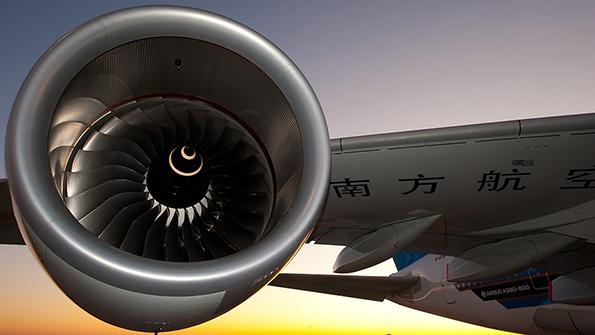
The imminent end of Airbus A380 production combined with a soft secondary market sets up an interesting product-support story for suppliers. While some operators are cutting back, others plan to keep flying the A380s they have, which will create ongoing demand for maintenance. But the absence of second-hand demand means parked A380s will be used to support the in-service fleet, which is expected to reduce demand for new parts.
The market is particularly murky for the A380’s two engine suppliers: Engine Alliance (EA), the GE-Pratt & Whitney joint venture, and Rolls-Royce. Engine Alliance is in product-support mode, as the last GP7200-powered A380 was delivered in early 2018. As of Feb. 1, Rolls had the remaining backlog of nine A380s—they are being built at the rate of six per year. The in-service fleet’s breakdown indicated 108 Rolls-powered aircraft, compared to 129 with EA engines, Aviation Week Fleet Data Services show.
Both engine OEMs are seeing retirements. Singapore Airlines has returned five Trent-powered A380s to lessors. Four belonged to Dr. Peters—two are being parted out, and two more are in storage. The fifth, owned by Doric, is on lease to charter specialist Hi Fly.
Air France is phasing out its 10 EA-powered A380s by 2022, citing the outsize challenge they present in scheduling as well as reliability issues as primary drivers. Air France-KLM CEO Ben Smith also cited investments that European competitors British Airways and Lufthansa have made in their A380 interiors as a factor. Air France faced costs of about $4 million per A380 to bring them up to the airline’s current standard—money it ultimately decided to spend elsewhere.
Emirates, which operates 114 of the 240 A380s in service or storage, including 25 Trent-powered ones, will retire some of its double-decker airliners and invest in others. Cabin upgrades are in the cards, and a new premium-economy class is expected to make its debut on an A380 delivered later this year. Emirates plans to keep its A380 fleet stable for several years before allowing it to decline to around 100 aircraft. The plan means its long-term fleet will be a mix of both engine types.
Qantas, another Trent 900 operator, debuted its upgraded A380 cabin last fall and plans to have all 12 refurbished and flying by 2021.
While no more A380s will be delivered after Emirates takes its final eight and All Nippon Airways takes one by mid-2021, investments made by several operators combined with having nearly two years of production to itself means Rolls faces perhaps two decades of ongoing support. High-pressure turbine blades have been redesigned to provide better durability, with further enhancements—including “design changes and manufacturing improvements”—slated to be introduced this year, the OEM says.
Rolls also made the best of the idle ex-Singapore airframes, leasing all 16 engines from Dr. Peters to help support the in-service fleet. Despite the two stored airframes having been idle since June and October 2018, respectively, Dr. Peters has not given up hope. “We are still exploring all available options to successfully place those two aircraft in the market [and] looking at the best value proposition for our investors,” a Dr. Peters representative says.
Even if the airframes do not move, their powerplants should see plenty of work. Aviation Week’s MRO Prospector projects 144 Trent 900 overhauls will be conducted across the 10-operator fleet over the next three years, roughly divided evenly within each 12-month period. Information from Aviation Week Fleet Data Services indicates that the average Trent-powered A380 is just more than six years old (see table), suggesting many have not undergone their first engine shop visits, which take place every 6-7 years, depending on an operator’s mission profile.
Even factoring in early retirements—Air France’s fleet will average slightly more than 10 years of age when the aircraft are parked—the A380’s fleet profile suggests many shop visits remain, particularly for the Rolls-powered fleet.



